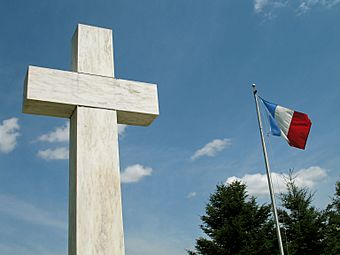Acadian Landing Site facts for kids
Quick facts for kids |
|
|
Acadian Landing Site
|
|
 |
|
| Nearest city | Madawaska, Maine |
|---|---|
| Area | 2 acres (0.81 ha) |
| Built | 1785 |
| NRHP reference No. | 73000098 |
| Added to NRHP | September 20, 1973 |
The Acadian Landing Site, also known as the Acadian Cross Historic Shrine, is a very important historical place for the Acadian people in northern Maine. It's located on the southern bank of the Saint John River, just east of Madawaska. A large marble cross marks the spot. This site is believed to be where the first Acadian families landed when they came to settle this part of the Saint John River. It was added to the National Register of Historic Places in 1973.
Contents
A Special Place for Acadians
The Acadian Landing Site tells an important story about the Acadian people. They are a group of French-Americans who have a unique history. This site marks a new beginning for many of them.
Why the Acadians Moved
During a big conflict called the French and Indian War in the 1750s, British officials in Nova Scotia made a difficult decision. They decided to move the Acadian people living there to other parts of the British Empire. This event is sometimes called the "Great Upheaval." Many Acadians were forced to leave their homes.
However, not all Acadians were moved. Some managed to stay, and many who were moved later found their way back to what is now New Brunswick. After the American Revolutionary War, people loyal to Britain, called United Empire Loyalists, moved to New Brunswick. They were given land, and sometimes this land was already occupied by Acadians. This meant some Acadians were forced to move again.
Finding a New Home in Maine
In 1785, a group of twenty Acadian families, led by Joseph Daigle, traveled up the Saint John River. They started their journey from Fredericton. According to local stories, their long journey ended at this very spot. To mark their arrival and new beginning, they put up a wooden cross.
This group of families became the start of new communities on both sides of the river. Today, the Canada–United States border runs through this area, dividing the larger Acadian community. The border was officially set in 1842 by the Webster–Ashburton Treaty. This happened after some disagreements about the border, known as the Aroostook War.
The Cross and the Site Today
The original wooden cross is no longer there. Instead, a large marble cross was put up in 1922. It stands near where the first cross was believed to be. The site is located near United States Route 1, past a potato field. You can reach it by a small side road.
In 1969, a wooden platform was built around the cross. Sometimes, special religious gatherings are held here. The Madawaska Historical Society now owns and takes care of this important historical site. It is also part of the Maine Acadian Culture program, which is run by the National Park Service. This program helps to preserve and share the history and culture of the Acadians in Maine.



